FREEWING A4 SKYHAWK 80MM EDF PNP
more info:
http://www.freewing-model.com/freewi...-airplane.html
Specifications
Model type: PNP EDF jet
Skill level: Intermediate/advanced
Wingspan: 37 inches
Wing area: 372 square inches
Airfoil: Delta planform wing
Length: 56.3 inches
Weight: 77.6 ounces
Power system: 80mm EDF
Radio: Minimum six-channel recommended
Construction: EPO foam
Covering/finish: Matte Navy gray over matte white
Test-Model Details
Motor: Freewing 3530-1850 Kv brushless outrunner
Battery: Admiral 6S 22.2-volt 4,000 mAh and 5,000 mAh (4,000 to 5,200 mAh with minimum C rating of 35C recommended)
EDF: Freewing 80mm with 12-blade impeller
Speed controller: Freewing 100-amp brushless with EC5 connector
Flight duration: 3.5-minute flights with 4,000 mAh battery
Pluses
• Nimble performance, efficient power system, excellent power-to-weight ratio.
• Includes both USAF and USMC waterslide graphics schemes, removable stores (two drop tanks, two AGM-12 Bullpup missiles), and removable 20mm cannon barrels and refueling probe.
• Excellent roll, climb, speed, and takeoff characteristics without sacrificing stability.
• Scale landing gear and detailed and functional split flaps.
• Multipin interface boards for easy removal of wings.
• Ball-link connectors on each hinged control surface for crisp performance.
Minus
• The nose gear strut is long and might not perform well or hold up to uneven grass or bumpy surfaces.
Product Review
Talk around the flying field and in the online forums made it abundantly clear that a new Freewing 80mm Scale electric ducted-fan (EDF) jet was on the way. Many jet pilots were hoping that the new EDF would be an 80mm A-4E/F Skyhawk. Nicknamed “Scooter,” this Vietnam-era warbird was designed by Ed Heinemann in the 1950s and focused on low-cost, outstanding performance, and a straightforward, durable design.
The famed Heinemann’s Hot Rod boasted a scorching 720° roll rate per second (two complete rolls per second), exceptional subsonic speed, and maneuverability that endeared it to many a military aviator.
The appearance of a large, Plug-N-Play (PNP) 80mm A-4 on Freewing Model‘s website, festooned in either U.S. Marine Corps or U.S. Navy graphics with an included scalelike, removable dorsal blister held firmly in place by four strong magnets and plastic guide pins, had many EDF jet pilots jumping for joy!
An initial walk-around of this new EPO foam model reveals how successfully Freewing has rendered the scale lines and unique details of the full-scale aircraft. The model includes an accurately represented plastic molded/painted refueling probe and 20mm cannons, both of which are removable, and large outboard ailerons.
The EPO foam airframe comes out of the box prepainted and ready to accept one of the two included graphics schemes. A full complement of underwing armaments comes with the kit.
Freewing did a commendable job of reproducing the manner in which the ailerons blend into the wingtip area. This attention to scale detail also manifests itself on the elevator surfaces. The result is a truly accurate scale silhouette. A matte Navy gray color covers the upper surfaces, and a matte white covers both sides of each control surface and the underside of the model.
Intakes, fairings, antennae, tailhook, under-wing pylons, and the inclusion of six small, plastic leading edge (LE) aerodynamic “fences” add to the scalelike appearance. Each of the two jet intakes is framed in smooth red plastic, which adds a nice finishing touch in the appearance department and improves the foam composition airframe’s durability.
Scale main gear that rotate 90° before fully retracting into molded wheel bays grace the underside of the delta wing. Also on the underside is an example of a new feature for Freewing aircraft: thinly molded plastic split flaps. The flaps use plastic hinges, are painted red on the inside, and include accurate scale surface details.
Freewing even adds a convex molding that, with the flaps fully lowered, mates into the aft portion of each main gear fairing. Hardcore A-4 aficionados might lament the lack of functional LE slats on the model.
All servos are 9-gram metal gear, except the single elevator servo that is a beefy 17-gram metal gear. Each elevator surface is connected by an inconspicuous plastic spar. This is a different approach from other Freewing aircraft, which typically rely on two servos for each elevator surface.
Wrenching a little on each elevator surface reveals no indication of differential slop or looseness. Every control surface has quality metal pushrods and uses plastic hinges. Ball-link connectors are used on all servo horns. This hardware is a must for any intermediate-to-advanced model! Bravo to Freewing for taking its aircraft in this direction.
A slightly elongated nose gear strut results in the Freewing A-4 sitting on its landing gear in a manner that is similar to the full-scale aircraft. The small nose cone is easily removed from its magnetic holders and the tip is molded plastic.
The kit includes two accurately represented large EPO foam fuel tanks. These tanks were often used on the full-scale aircraft and they do justice to the Freewing A-4’s scale silhouette.
Also included are two AGM-12 Bullpup missiles. All stores are easily added to or subtracted from the A-4 via four underside stores pylons and associated magnetized fasteners.
Assembly is straightforward, with both wing halves, elevator, and vertical stabilizer going together using the supplied screws. The kit includes the requisite tube of contact-style glue. It can be used to attach the antennae, fences, stores, pylons, tailhook, and exhaust nozzle.
This PNP kit includes a silky-smooth 80mm Freewing EDF power system and assembles using fasteners and adhesive.
To easily remove the wing, Freewing uses multipin boards to aggregate aileron, flaps, and landing gear servo leads. The manual provides detailed instructions on pushrod/clevis/control horn setup with low- and high-rate settings for all control surfaces. The manual also includes recommendations for setting the flap deflection and elevator mixing in a pilot’s transmitter. It is recommended that modelers follow these instructions verbatim.
In connection with attaining the correct center of gravity (CG), there is an addendum in the manual that states that loading stores (the fuel tanks and/or missiles) will cause the CG to move slightly aft. To counter this, pilots should add their desired stores, check the CG, and then make any appropriate adjustments by repositioning the battery in the fuselage. The battery tray is lightweight wood stock. Pilots should mark the wood with a pen for the correct CG location when using different size batteries and also mark any CG differences resulting from stores options.
Add a receiver, secure a six-cell 4,000 to 5,200 mAh battery (there is plenty of room) in place with the supplied hook-and-loop strap, snap the spring-loaded, latch-equipped canopy in place, and this A-4 is ready to fly.
Flying
With setups and rates settings replicated according to the manual, high rates were selected for everything except the elevator. Thirty percent exponential was programmed all the way around. When performing the maiden flight on a new EDF, underwing ordnance can often improve visual orientation and even improve stability. With that thought in mind, the AGM-12 Bullpup missiles were loaded to the outer pylons.
A freshly charged 35C Admiral 6S 4,000 mAh battery was loaded all the way forward in the fuselage and the CG was verified. Pre-maiden flight thoughts that jet pilots might find themselves musing about include whether the nose-high posture of the A-4 will enable premature rotation during takeoffs and whether the relatively small delta wing, equipped with large outboard ailerons, coupled with an airframe that appears to have a higher CG, will create a model that is twitchy on the ground and dynamically unstable aloft.
The runway at the local club is constructed of a typical geotextile material and is relatively smooth. Slowly advancing the throttle spun the 12-blade Freewing impeller to life and created an incredible-sounding metallic whine and whoosh. The A-4 tracked straight and true down the runway, and with a little back elevator applied, transitioned into a clean rotation with a positive rate of climb.
The A-4 showed no sign of springing into the air on its own because of its nose-high stance. Many of the Freewing EDF jets are excellent at storing energy in the form of airspeed and do not necessarily depend on an excess of raw thrust.
At medium altitude, aerobatic maneuvers can be initiated at half throttle. Half Cuban 8s and full Cuban 8s, when performed in this manner, allow the model to zoom over the top without a hint of stall or elevator mush from an excessive loss of airspeed. Inverted flight requires little corrective elevator input. The A-4 feels as though it is on rails when performing full-flap, low-altitude passes on the deck. Aileron rolls at a mere half deflection of the right stick will cause this A-4 to perform some incredibly crisp, amazingly axial, and almost blindingly fast rolls.
After it is trimmed out, this jet rotates into the air on takeoff in a scalelike manner. A small bump of up-elevator is all that is required for liftoff.
The 80mm fan sounds smooth right out of the box, with no audible undulations, lack of power, or indications of imbalance at any throttle setting. Elevator response is precise, with the 17-gram metal gear servo capably doing its job.
Pilots will want to play it safe and start the transition into the landing pattern at approximately 31/2 minutes into the flight. Best practices for landing include dropping the gear and a first notch of flaps when on the downwind leg. A wide, gradual descent and decrease of power/altitude during the downwind leg and on through to base and final works best. Keep the turns shallow, with a little rudder added. The outline of this Vietnam War-era jet coming down the pipe with a steady rate of descent and constant angle of attack is amazing.
Decrease the power and the A-4 will touch down smoothly with plenty of runway left. Pilots need not feel concern that the scale split flaps are all drag and no lift. Freewing got the wing area and camber right and the result is a jet that is predictable and even slightly floaty on final approach. A 31/2-minute flight saw the 4,000 mAh six-cell LiPo battery with roughly 30% capacity left.
Conclusion
The 80mm Freewing A-4E/F Skyhawk, the latest Vietnam-era EDF in the Freewing lineup, is what many EDF enthusiasts have been waiting for. It has a big 90mm feel to it and an imposing presence in the air and on the ground. This A-4’s shortcomings are difficult to find. Although the main gear is large enough for operations from unimproved fields, the length of the nose gear and smaller wheel size could make grass operations slightly difficult.
The included military waterslide graphics look great, but pilots might wish to apply a coat or two of water-based polyurethane clear coating to help keep them firmly in place. And the large size of this 80mm airframe fairly begs for additional nomenclature markin
FREEWING A-4 SKYHAWK 80MM EDF ASSEMBLY & FLIGHT REVIEW
I keep telling myself to scale back on the foam airplanes, but when the Freewing A-4 Skyhawk came up on pre-sale, I knew I had to have one! The A-4 is a classic design that I’ve always appreciated. In fact, I still remember seeing the Blue Angels fly A-4s back in the 80’s. It was such an agile yet graceful airplane to watch fly, they will probably always be my favorite Blue Angel aircraft.
For those who and for full disclosure up front, this airplane flies really well when setup right, but I actually crashed the airplane twice in the process of making this review…mostly a result of my own error. The first time was due to installing an already flown battery into the airplane. It only took a couple laps before the fan quit and of course it was too low to get back to the runway. Bummed, but not to be defeated the airplane was refinished with a few upgrades (which we’ll talk about). It came out beautiful, I loved it! Unfortunately, the CG moved further back than I anticipated and the airplane over rotated on the second takeoff and I didn’t have enough altitude to fully recover. It’s fixable, though I’ve debated just buying a replacement instead…it’s currently hanging in my shop waiting in limbo.
With that being said, I still wanted to provide this review because as I mentioned, the airplane flies really well. But, it’s an A-4 and there definitely some things to be aware of when setting it up for best success.
As a whole, the airplane is a really nice representation of the A-4 and it’s a great size for an 80mm airplane. Not exactly 100% scale, but definitely pretty close and a really nice addition to the growing freewing 80mm line. The finish is nice and quite smooth, definitely one of the smoother freewing airplanes I’ve experienced to date. External wing tanks and bullpup missiles are included which is a nice touch. I regularly flew with the tanks, but never flew with the bullpups. The avionics hump is included as well which is kind of a must for an A-4. There’s something slightly off about the canopy shape and I found that placing the avionics hump on the back actually made the nose section look more accurate, so the airplane was always flown with it on.
A couple of things that are worth pointing out are that all of the wing servos plug into a single connector which is nice. This makes removing the wings easier. Also, the airplane was packaged well, but there was one spot where the wing connector wire got pressed into the fuselage during packing. It was a pretty deep ding, but easy enough to fix with some filler. Unfortunately, there are no gear doors included with the kit. I’m sure it was all in keeping the price down and keeping it simple. However, this is a really nice looking airplane and I would have paid the extra to have those on the airplane out of the box. The other thing is that though the nose gear doesn’t look bad, the main gear are a very non-scale trailing link style gear which kind of kills me (I just have this thing about landing gear… �� ). If you want to upgrade, the 90mm Eurofighter mains (link is strut and retract as I was unable to find just the strut on Freewing Model’s website) are a quick and easy replacement.
AIRCRAFT SETUP & CG
For the radio setup and CG, there are definitely some things to be aware of that will help keep the shiny side up. First of all, A-4s are like deltas in that they need much more elevator than aileron throw. As a whole, A-4s don’t need much aileron throw at all. Freewing’s recommendations are way too hot, so be aware of that. The airplane will roll like a drill bit with their recommended throws. So, for the maiden, I setup the recommended low rates as my high rate and then added 2 lower rates from there. Through flying the airplane, I settled on the following:
Elevator: 1/2″-9/16″ each way with 15% Expo
Aileron: 5/16″ each way with 10% expo
Rudder: 1-3/8″ with 15% expo to desensitize the steering
Flaps: 1″ mid and 2″ for full (no elevator mixing).
On the CG there are some things to be aware of here as well. First of all, starting off a bit nose heavy is definitely recommended. Once familiar with the airplane, then start looking at moving the CG back a little bit if desired, however through flying the airplane with an aft CG, the airplane would do an uncommanded pitched up when it got too slow in the flare with the power off. As a result, there were a couple tail strikes experienced on landings. Moving the CG forward alleviated the issue all together.
Based on this, I recommend setting the CG at 180-185mm as measured from the wing root gun cut out aft. The airplane is a little nose heavy there, but it flies and lands really well at this location. So consider this a starting point and then look at moving the CG back after a couple flights if desired. Just be aware of the pitch up that the airplane does with an aft CG. That’s where I got into trouble with the refinished airplane.
REFINISH AND UPGRADES
Before talking flying, let’s talk about the refinish and upgrades briefly. I was so bummed with the crash as the airplane looked so good!
The first upgrade added was a nose gear door, This was made out of sheet styrene and then hinged in the plastic cover that’s on the model. 3/16″ balsa stiffeners were added in the gear cutout in the fuselage to stiffen the cutout and also serve as a ledge for the door to rest against when closed. For the door, the hinges were setup and glued first and then the perimeter of the door was lined with 1/16″ balsa with about 3/32″ space all around. The door was then finished up by adding an inner cover from sheet styrene which really stiffens the door to help it hold its shape. A spring was made out of 0.032 wire which pushed the door open and then some fishing line was used to pull the door closed as the gear retract (elastic cord works too). The fishing line was fastened to the door and then the gear was retracted and the fishing line was pulled tight to close the door and the fastened to the fuselage. The “just fly with tanks” choice was made to avoid making main landing gear doors since they basically hide the lack of main doors.
The second upgrade was the upgrading all of the struts. As mentioned previously, the 90mm Eurofighter strut worked great for the mains. The wire receiver holes at the base of the stsrut do require being drilled out which should be done carefully stepping up the drill size incrementally (pretty soft aluminum). The springs are really stiff, so they were cut down such that there was no compression on the spring when the struts were fully extended. The nose was also replaced with a specially built one my friend made for me. He used the euro main strut and grafted the lower fork and tire from the Mig-21 onto it using epoxy and carbon thread. It looked really awesome on the model!
The last bit of detail added were the vortex generators. This was accomplished using some 1/4″ wide 0.020″ thick strip styrene plastic cut at 1/4″ lengths. A template was made from a CAD drawing to plot out the VG locations and used a pencil to plot it all out (download the template here!). From there, slots were cut in the wing at each location and the plastic pieces inserted, aligned, and glued with thin CA.
Lastly, on the refinish itself, a similar process to what has been shown in our warbird refinish and Kfir kit bashing series with the exception that neither the paint was stripped nor the panel lines filled in. The stock airframe finish was lightly sanded and then all prep was done over that. Additionally, instead of using 6 coats of minwax polycrilic applied with a foam brush, 2 coats were applied using a spray can version.
The weathering was similar to what we explained in our kit bash weathering videoexcept that a lightened base color was used to fade the centers of the panels vs using a black shade over the panel lines themselves. The black created too harsh a look based on the depth of the panel lines. To bring out the panel lines slightly, Raw Umber acrylicthinned down with water and tamiya acrylic thinner was used as a wash and sprayed over all of the panel lines. Once sprayed, the acrylic was wiped off in the direction of the airflow on the flying surfaces and vertically on the fuselage and dorsal using a paper towel and tamiya acrylic thinner. For heavier streaking the unthinned raw umber was used in the same manner as described in the Kfir weathering video. The weathering came out really nice and looked about perfect when finished. Note that I plan to do a from the bench discussion later this year outlining all kinds of different weathering techniques and ways to use them, so just a heads up there.
One final item of business the airplane was screaming for was a centerline multiple ejector rack (MER). I started this before the “incident” and finished it up after, so I never got a chance to fly with it on, but they came out really awesome. If I do another A-4, it’ll be flying with this MER! Note that the MER kit is available on my 3D Printed Productspage if you’re interested.
FLYING THE FREEWING A-4 SKYHAWK
In short, when this airplane is setup right, it flies pretty awesome! The airplane tracks well, has good authority and presence, and just looks good in the air. It’s not the fastest 80mm jet out there, but it moves out decently and pulls well into the vertical. Flying with and without the tanks, there’s a little difference in top end speed, but otherwise there’s not a huge difference in performance that was noticed. My preference was to fly the airplane with the tanks as it made the A-4 a little easier to see and seemed to help the airplane track just a little bit truer in the air.
Through flying the airplane, covering the cheater aux air grate on the underside was played with by taping it over with no discernable difference in the aircraft flight performance noted. In fact, the airplane got a little quieter in the process. The inlets themselves are at about 100% of the fan swept area, so there’s really no need to have the aux air grate underneath. So, in the refinish, it was closed up more permanently. One important thing to mention is to calibrate the speed controller before the first flight as this will ensure getting max power out of the fan at full throttle. To do that, simply plug the airplane in with the radio on and the throttle at full. Wait for the ESC to beep twice, and then bring the throttle back to idle. The ESC will then arm and it’s all calibrated and ready to go.
Here’s a short flight video of the airplane in action. This is the aircraft bone stock before the refinish with the tanks on and the cheater grate taped over.
The RC Geek's Freewing A-4 Skyhawk flight at Wingmasters SD (3 min 44 sec)
FINAL THOUGHTS
There we have the Freewing A-4 Skyhawk. This is a good flying EDF that looks good out of the box. A-4s do take some extra attention in setup, so keep that in mind and you’ll have a lot of fun with the airplane. I do wish that gear doors would have been included, but I suppose not everyone is a staunch scale nut like myself. I’ve been on the fence of getting another one actually, so that should say something about how much I liked it!
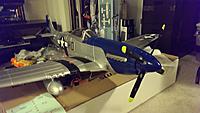


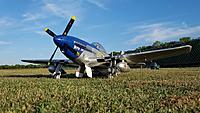
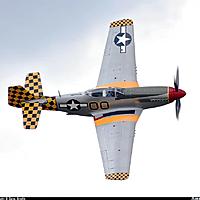
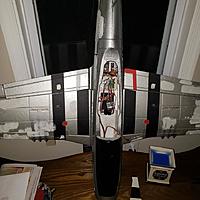
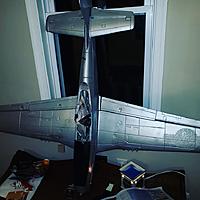




















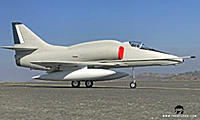

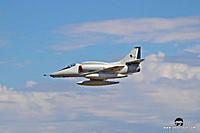

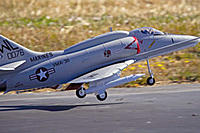
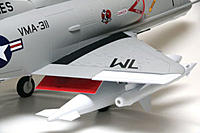





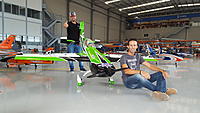
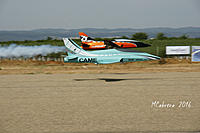

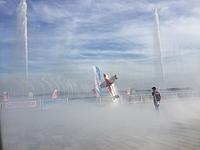
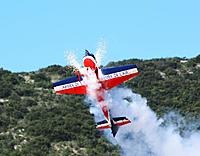

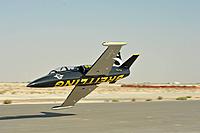



 )
)